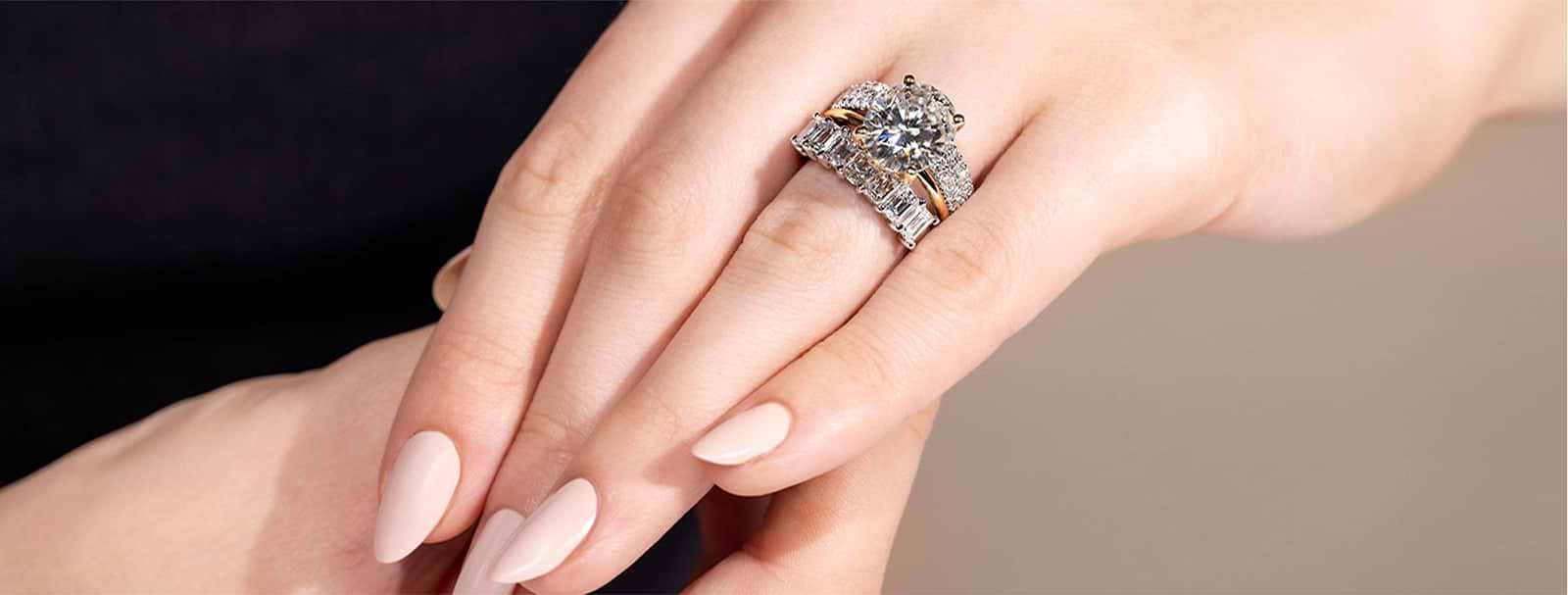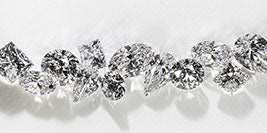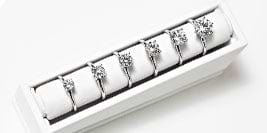
Lab Grown Diamonds

-
MiaDonna's collection of lab grown Diamonds are real, pure carbon diamonds and share the same optical, physical, and chemical properties as an Earth-Mined diamond.
It’s like getting ice from your modern-day controlled environment called your freezer versus getting it from a glacier. No matter the origin, both are chemically, physically, and optically identical.
It’s the same with our lab grown Diamonds. We are just mimicking the natural growing process of a diamond in our modern-day controlled environment. -
We use a technology called Chemical Vapor Deposition (CVD).
Scientists start by cutting a small piece of carbon, known as a seed. Next, the seed is placed in a CVD chamber. Gases combine with electrical energy, which creates a chemical reaction and ignites a plasma ball, causing the seed to grow. Within 6-12 weeks, a sizable rough diamond is formed. It is then cut, polished, and graded the same way as an earth-mined diamond. -
It takes 6-12 weeks to grow a sizable rough diamond in a lab, which is the same amount of time that we estimate it takes for a diamond to form in the earth.
A common misconception is that it takes billions of years for the earth to create a diamond. However, earth-made diamonds were actually formed billions of years ago when the earth was much hotter and had more volcanic activity. They were also formed in 6 to 12 weeks, they have just been sitting on the earth for billions of years.
Fun Fact: The earth is not making any more diamonds, just like the earth isn’t making any more oil. Earth's environment is no longer hot enough to create diamonds, and it’s estimated that by 2030 there will be no more diamonds on the earth to mine. -
A CVD diamond is a lab grown Diamond. CVD stands for Chemical Vapor Deposition, which is the technology used to create lab grown diamonds.
CVD is the primary way used to create diamonds in a lab, as it produces larger, colorless diamonds. -
Yes, a CVD diamond is a lab grown. CVD stands for Chemical Vapor Deposition, which is the technology used to create lab grown diamonds. CVD diamonds are increasingly becoming popular as an alternative to natural diamonds due to their cost-effectiveness, ethical sourcing, and the ability to control the size, shape, and quality of the final product.
-
It's a post-treated colorless diamond, also known as “diamond treatment,” “treated diamond,” and “enhanced diamond” is a method used to improve the clarity and/or color of poor quality diamonds.
What is a treated diamond? You do not want post-treated diamonds in Earth-Mined or lab grown because it makes a diamond more fragile and susceptible to breakage.
Here is the problem with cheaper, post-treated diamonds on the market. After a CVD chamber has completed a "cycle" of creating diamonds, it needs a "cooling" period for up to 5 days. Then it is cleaned using technical cleanroom measures to remove the excess carbon "junk" buildup off the interior wall of the CVD chamber and to avoid any other potential contamination for the next growth cycle.
Unscrupulous companies are now skipping this cooling and cleaning process as they want the machines to be continuously running to produce more diamonds in a shorter period of time. This means the carbon "junk" on the interior walls of the CVD chamber is now mixing in with the new carbon, creating brown diamonds, not colorless diamonds.
To fix this, they are post-treating these "brown" diamonds with an HPHT treatment. Heating them to extreme temperatures to turn them colorless, but at the same time destroying the internal integrity of the diamond.
MiaDonna's USA-grown diamonds are created without post-treating. -
An HPHT diamond is a lab grown diamond. HPHT stands for the technology used to create it: High-Pressure High-Temperature.
As the name suggests, these lab grown diamonds are formed by exposing carbon to extreme pressure and heat. This was one of the first technology used to create diamonds in a lab, patented by GE in the 1950s.
This is the technology we used when MiaDonna was first founded in 2005. However, the technology showed limitations in growing larger colorless diamonds, so in around 2010 we moved to CVD technology to create our lab diamonds. -
Lab grown Diamonds cost up to 40% less than the Rapnet price of mined diamonds. This is because a mined diamond can exchange hands 20 times and travel to 5 countries before it reaches the consumer and each person on a diamond's journey is making a profit. MiaDonna lab grown Diamonds go from the lab to our casting house to the consumer.
-
We have coined the term "ethically sourced" lab grown Diamonds because not all lab grown Diamonds are created equal—and neither are the companies that sell them. Unscrupulous retailers market lab grown Diamonds that could not be classified “conflict-free” or "ethically sourced" by anyone’s measure, sourced from manufacturers who inflate profits at the cost of quality and the environment. We take ethics very seriously at MiaDonna, and our lab grown Diamonds only come from sources that are either SCS certified, we have personally visited and inspected, or had relationships with for over a decade.
-
Hardness with reference to gemstones is often misunderstood. The word “hardness” has a very specific scientific meaning in gemology that differs considerably from its everyday usage. The scientific definition of hardness is the ability to resist scratching, nothing more. For example, if you asked someone if a feather and glass are soft or hard, they’ll say feathers are soft and glass is hard. In the world of gemology, however, glass is soft. It can be scratched easily by a variety of what gemologists consider harder substances.
The Mohs scale was created to be a reference for the 10 most common minerals ranked in order of increasing hardness. At the top of the scale is diamond (10) and directly below it is Corundum (9), which is what rubies & sapphires are made from.
Each of these minerals can be scratched by the substances above it and will scratch the ones below it. Minerals of the same hardness won’t scratch each other. Thus, a ruby can’t scratch a sapphire and vice versa. A diamond is much harder than corundum, even though they’re only one division apart on the scale. The Mohs scale starts approximately linear, but the curve climbs sharply at the high end. The Diamond Hybrid® (8.8) is almost twice as hard as topaz (8), and diamond (10) is four times as hard as the Diamond Hybrid®. -
An "As-Grown Diamond" means a diamond has not been post-treated to increase its color and clarity of the diamond. You only want an "As Grown Diamond" because post treatments can make diamonds fragile.



























